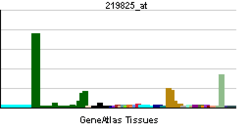CYP26B1
| View/Edit Human | View/Edit Mouse |
Cytochrome P450 26B1 is a protein that in humans is encoded by the CYP26B1 gene.[3][4]
This gene encodes a member of the cytochrome P450 superfamily of enzymes. The cytochrome P450 proteins are monooxygenases that catalyze many reactions involved in drug metabolism and the synthesis of cholesterol, steroids and other lipids. The enzyme encoded by this gene is involved in the specific inactivation of all-trans-retinoic acid to hydroxylated forms, such as 4-oxo-, 4-OH-, and 18-OH-all-trans-retinoic acid.[4]
CYP26B1 has been shown to be over-expressed in colorectal cancer cells compared to normal colonic epithelium. CYP26B1 expression was also independently prognostic in patients with colorectal cancer and strong expression was associated with a poorer outcome.[5]
References
- ↑ "Human PubMed Reference:".
- ↑ "Mouse PubMed Reference:".
- ↑ Nelson DR (Dec 1999). "A second CYP26 P450 in humans and zebrafish: CYP26B1". Arch Biochem Biophys. 371 (2): 345–7. doi:10.1006/abbi.1999.1438. PMID 10545224.
- 1 2 "Entrez Gene: CYP26B1 cytochrome P450, family 26, subfamily B, polypeptide 1".
- ↑ Brown, Gordon; Beatriz Cash; Daniela Blihoghe; Petronella Johansson; Ayham Alnabulsi; Graeme Murray (2014-03-07). "The Expression and Prognostic Significance of Retinoic Acid Metabolising Enzymes in Colorectal Cancer". PLOS ONE. doi:10.1371/journal.pone.0090776.
Further reading
- Rat E, Billaut-Laden I, Allorge D, et al. (2006). "Evidence for a functional genetic polymorphism of the human retinoic acid-metabolizing enzyme CYP26A1, an enzyme that may be involved in spina bifida". Birth Defects Res. Part a Clin. Mol. Teratol. 76 (6): 491–8. doi:10.1002/bdra.20275. PMID 16933217.
- Bowles J, Knight D, Smith C, et al. (2006). "Retinoid signaling determines germ cell fate in mice". Science. 312 (5773): 596–600. doi:10.1126/science.1125691. PMID 16574820.
- Hillier LW, Graves TA, Fulton RS, et al. (2005). "Generation and annotation of the DNA sequences of human chromosomes 2 and 4". Nature. 434 (7034): 724–31. doi:10.1038/nature03466. PMID 15815621.
- Gerhard DS, Wagner L, Feingold EA, et al. (2004). "The Status, Quality, and Expansion of the NIH Full-Length cDNA Project: The Mammalian Gene Collection (MGC)". Genome Res. 14 (10B): 2121–7. doi:10.1101/gr.2596504. PMC 528928
 . PMID 15489334.
. PMID 15489334. - Strausberg RL, Feingold EA, Grouse LH, et al. (2003). "Generation and initial analysis of more than 15,000 full-length human and mouse cDNA sequences". Proc. Natl. Acad. Sci. U.S.A. 99 (26): 16899–903. doi:10.1073/pnas.242603899. PMC 139241
 . PMID 12477932.
. PMID 12477932. - Trofimova-Griffin ME, Juchau MR (2002). "Developmental expression of cytochrome CYP26B1 (P450RAI-2) in human cephalic tissues". Brain Res. Dev. Brain Res. 136 (2): 175–8. doi:10.1016/S0165-3806(02)00305-X. PMID 12101034.
- Abu-Abed S, MacLean G, Fraulob V, et al. (2002). "Differential expression of the retinoic acid-metabolizing enzymes CYP26A1 and CYP26B1 during murine organogenesis". Mech. Dev. 110 (1–2): 173–7. doi:10.1016/S0925-4773(01)00572-X. PMID 11744378.
- White JA, Ramshaw H, Taimi M, et al. (2000). "Identification of the human cytochrome P450, P450RAI-2, which is predominantly expressed in the adult cerebellum and is responsible for all-trans-retinoic acid metabolism". Proc. Natl. Acad. Sci. U.S.A. 97 (12): 6403–8. doi:10.1073/pnas.120161397. PMC 18615
 . PMID 10823918.
. PMID 10823918.
